Mac Musings
The 10 Most Important Macs
Daniel Knight - 2005.02.22
Last week Mobile PC magazine declared the PowerBook 100 the #1 gadget of all time, beating out the Swiss Army Knife, the iPod, pocket calculators, the transistor radio, cell phones, Palms, the original Sony Walkman, and the wireless remote control.
Over the weekend, MLAgazine posted Top 10 Apples by Michel Munger, which also listed the PowerBook 100 as one of Apple's most important creations - along with the Mac Classic, the iMac, the PowerBook G3 (Pismo), and first generation Power Macs.
Both articles were a nice trip down memory lane for someone who has been into personal computers since the Apple II+ era. I remember personal computing before Windows, before the Macintosh, before the IBM PC, and before MS-DOS.
It's been fascinating watching the personal computing world evolve from 1 MHz CPU with 1-4 KB of RAM into today's powerhouses with GHz CPUs and MB of RAM. And Apple's been part of it since 1977.
Looking only at Macintosh hardware, here's our chronological list of the most important models of the Mac's first 21 years.
- The Macintosh, 1984
- Macintosh Plus, 1986
- Macintosh II, 1987
- PowerBook 100, 1991
- Quadra 840av, 1993
- Power Mac 6100, 7100, and 8100, 1994
- PowerBook 500 Series, 1994
- The iMac, 1998
- 12" Dual USB iBook, 2001
- The Mac mini, 2005
The Macintosh, 1984
Apple spent years developing the Macintosh, which was originally going to be a low-cost information appliance with an 8-bit CPU and 64 KB of RAM. By the time Apple unveiled the Macintosh, it had evolved into an 8 MHz computer with 128 KB of RAM and a Motorola 68000 CPU.
The Mac was very different from the Apple II line and what was available in the PC world. It was similar to Apple's Lisa at first glance, but with a smaller screen (9" vs. 12"), less memory (128 vs. 1024 KB), a smaller keyboard (no arrow keys or numeric keypad), a faster CPU (8 vs. 5 MHz), and a far lower price (US$2,495 vs. US$9,995).
The original Macintosh brought graphical computing a broader market and made the mouse a de facto feature of computing. Every computer and every operating system on the market today owes something to the Mac 128K.
This isn't to say the Mac was without shortcomings. The 9" display was small, although that helped keep the size, weight, and cost down. The keyboard lacked cursor keys, something Apple addressed in 1986.
Mostly, though, 128 KB of RAM and a single 400 KB floppy drive didn't quite cut it, forcing users to buy an external floppy or do the floppy shuffle. When Apple was able to boost RAM to 512 KB later in the year, the Macintosh became a much more satisfying computer.
Macintosh Plus, 1986
I have a soft spot for the Mac Plus. Not only was it the first Mac I used or owned, but it was also Apple's low-end solution after the Mac SE was introduced.
The Mac Plus had the same design as the original Mac, but it came with 1 MB of RAM, a double-sided 800 KB floppy drive, and a keyboard with both a numeric keypad and arrow keys. Thus it addressed the biggest complaints about the Mac 128K.
The Mac Plus went beyond that. Recognizing that hard drives were here to stay, the Plus was the first Mac with a hard drive interface. The SCSI port would be found on every Mac until the iMac was introduced in 1998.
The Mac Plus was also the first Mac to be designed with memory expansion in mind. Although it shipped with 1 MB of RAM - which seemed like a whole lot at the time - memory could be expanded to a very impressive 4 MB.
Discontinued in October 1990, the Mac Plus had the longest product life of any Macintosh.
Macintosh II, 1987
Until March 1987, every Macintosh looked the same. Then came the Mac II, the first modular Mac. Like the IBM PC, it had room for two floppy drives, a hard drive, and several expansion cards. Unlike the IBM PC, it ran the Mac OS.
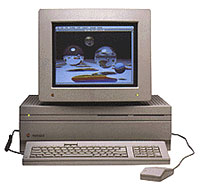
The Mac OS had to evolve to support color, and the Mac II allowed up to six video cards at once. The first color cards allowed 4-bit/16-color or 8-bit/256-color video - and those 256 colors could be selected from a 16 million color palette, giving the Mac II some of the most impressive color graphics of that era.
The heart of the Mac II's expandability was the NuBus expansion slot, which supported video cards, networking cards, DOS cards, high speed SCSI controllers, and coprocessors. NuBus slots would be a feature of high-end Macs until 1995, when Apple adopted PCI expansion cards.
Also new to the Mac line in 1987 was the Apple Desktop Bus, a technology pioneered on the Apple IIgs for connecting a mouse, a keyboard, and other peripherals to the Mac. Apple used ADB on every Mac until the iMac was introduced in 1998.
PowerBook 100, 1991

Apple's first battery-powered Mac, the Mac Portable, was a no compromise behemoth. It had a full-sized keyboard with either a numeric keypad or a trackball. It ran a 16 MHz 68000 CPU with 1-9 MB of RAM. It had a big (by 1989 standards) 40 MB hard drive. And the active matrix screen was incredible, as was the 10 hour battery life.
But it was very heavy (15.8 pounds), very bulky, and very expensive (US$6,500 floppy only, US$7,300 with hard drive). The Portable was a nice enough computer, but the market wanted smaller, lighter, more transportable.
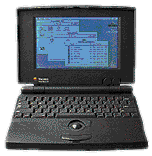
Apple contracted with Sony to reconfigure the Portable as a true laptop, and the PowerBook 100 was unveiled in October 1991. It had the same 16 MHz 68000 CPU, supported up to 8 MB of RAM, but it weighed just 5.1 pounds - one-third the weight of the Portable.
Introduced alongside the larger, heavier, more powerful PowerBook 140 and 170, the 100 tended to be overlooked. That's a shame, because the tiny size (about the same as today's 12" iBooks) and adequate power made it a great field machine.
The only place the PB 100 didn't match Portable specs was battery life. To keep things small and light, the 100 had a two-hour battery.
Other PowerBook innovations include moving the keyboard toward the screen, using a centrally located trackball in front of the keyboard, and SCSI disk mode.
Quadra 840av, 1993
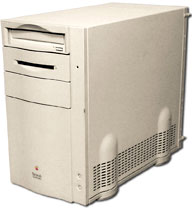
Apple's fastest 68040-based model, the Quadra 840av stood out more for its audio and video support than for its 40 MHz CPU. The Motorola 68040 may have been the brains of the AV Quadras (there was also a 25 MHz 660av), but the AT&T 3210 was its eyes and ears.
These digital signal processors not only allowed the AV Quadras to save video as QuickTime files, they also allowed real time compositing, making it possible for the Mac to add text or graphics to an incoming video feed and output video with titles, logos, or other things added to them.
Also new with the AV Quadras was Apple's GeoPort, a faster version of the serial port used in earlier Macs.
Power Mac 6100, 7100, and 8100, 1994
Apple moved the Macintosh line to a new family of CPUs in 1994, the PowerPC. The new CPUs were designed by Apple, IBM, and Motorola using IBM's POWER RISC architecture, some features from Motorola's ill-fated 88000 CPU, and intended for the Mac OS.
The 60 MHz Power Mac 6100, 66 MHz 7100, and 80 MHz 8100 weren't significantly faster than the Quadras they replaced, but they did move Apple from a dead-end architecture to one they still use today. If anything, the most impressive thing about the first Power Macs was that they worked so well on old software designed for Apple's old architecture.
Emulating the 680x0 CPUs was a big reason the Power Macs could be introduced when they were, and parts of the Mac OS remained in 680x0 code until the Mac OS 8.x era.
PowerBook 500 Series, 1994

Two months after introducing the Power Macs, Apple released the first PowerBooks with trackpads, stereo speakers, dual intelligent batteries, PC Card slots, and built-in ethernet. The "Blackbird" model was available in 25 MHz and 33 MHz speeds, with a color display or a grayscale one.
Top of the line was the PowerBook 540c, which had a 9.5" 640 x 480 8-bit color display. (Earlier PowerBooks had 640 x 400 screens.) With a pair of fully charged batteries, it could run for four hours in the field.
And if that wasn't enough, you could even buy a PowerPC upgrade.
The iMac, 1998
Apple acquired NeXT in 1996, which marked Steve Jobs' return to the company he co-founded. Jobs replaced Gil Amelio as CEO in 1997, and the first computer wholly designed under Jobs' leadership was the iMac.
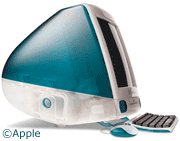
The iMac ran the same Mac OS as its contemporaries, but it sure looked different with its swoopy curves and Bondi blue accents. The shrunken keyboard and round mouse had their detractors, as did the absence of a floppy drive, but the iMac was destined for success.
While Mac mavens and industry pundits debated the merits and demerits of each design decision, the computing public was introduced to something different from the beige boxes with external monitors and too many cables. Apple got a lot of buzz, but it didn't do a very good job of letting Windows users know how productive they could be with an iMac.
Still, the iMac consistently made the best seller list as it went through one revision after another, new colors, and faster processors.
If Apple did anything wrong with the iMac, it was moving from a single model to multiple models at different speeds - sometimes offering four different CPU speeds and six colors at the same time. Yes, it provided plenty of choices, but it also created stocking problems and kept the iMac off the best seller lists, since no single model dominated sales.
12" Dual USB iBook, 2001
After showing that it could design a nearly bulletproof (also big and heavy) iBook for the education market and a thin, full featured G4 PowerBook for the power user, Apple introduced a practically perfect laptop with the 500 MHz iBook.
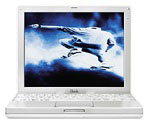
The "iceBook" was still rugged, although it lost the swoopy curves and bulk of earlier iBooks. The new 12" model was just as big as it needed to be for a 12" LCD and a full-sized keyboard - almost identical in size to the PowerBook 100, in fact.
The 1024 x 768 screen is great, and much better than the 800 x 600 displays in earlier iBooks or the wonderful PowerBook 1400 (which was nearly as small at the white 12" iBook). The design seems to be the perfect combination of size, weight, power, and battery life.
The basic design remains in use with today's 12" iBook G4/1.2 GHz and the aluminum-clad 12" PowerBook G4/1.5 GHz.
The Mac mini, 2005
Picking the ten most significant Macs isn't easy. It's a subjective thing, and while some models obviously make the list, as you move down the list it gets harder to choose which models will round out the Top Ten and which won't make the list.

Right now, I'm rounding out the list with Apple's newest computer, the Mac mini. As nice as the Power Mac G5 and G5 iMacs are, they are nice evolutionary machines with very nice design.
The Mac mini is revolutionary, and not just because it's the most affordable Mac ever. It's one of the smallest computers on the market period. It's the first desktop I know of designed around a 2.5" laptop hard drive. And, like the Mac Plus and the original iMac, it has everything you need, just enough expansion, and hardly anything you might not want or need.
The true revolution, however, is Apple pursuing the consumer market with a computer that not only gets a lot of buzz but is also in the same price range as entry-level Windows PCs.
There's nothing state-of-the-art about the Mac mini, but the same can be said of low-cost Windows PCs. There are nice things the Mac mini has that most Windows PCs don't - a slot loading drive, a tiny footprint, and whisper quiet performance. (In the Windows world, small PCs and quiet PCs tend to command premium prices.)
It's selling like hot cakes, and I think it's going to continue to do so.
All in all, I think the Mac mini will go down as the most significant model of the Mac's third decade.